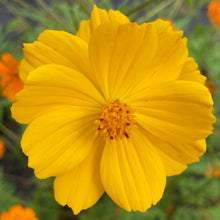
Planting Orange Cosmos seeds is sure to spark up a veritable wildfire of enchanting blossoms. This fast growing annual goes by the alternate names of ‘Klondike Cosmos’ and ‘Sulphur Cosmos.’ Alongside its stunning visual appeal, Cosmos sulphureus is excellent for cut flowers, and will be a prime watering hole for butterflies, wasps, flies, and lacewings. The pollinators they attract also feed on pest insects, another benefit of having this plant in your garden. Leaving the flowers to go to seed will encourage the continued growth of this flower when next summer rolls around. This crop thrives with very little management, save for the occasional watering, pruning, and the potential need for staking them up to support tall growth from flopping over.
In both Indonesia and Thailand, young shoots and leaves of Orange Cosmos are consumed raw, cooked, or in decoctions. With their neat arrangement of petals, this flower is often associated with order and harmony. This plays into the name ‘Cosmos,’ a name coined by Spanish priests from the Greek word indicating balance in the universe, ‘kosmos.’ Colonial Spanish forces brought this plant to Europe in the 1700s, where they became prominent in English gardens. From there they moved to South Africa, where they were often made into dyes, their use becoming prominent in Mexico and South America. As one could infer from their common name, these blooms produce a bright to deep orange or warm brown pigment. Their propensity to flower from spring to autumn makes for an abundance of plant matter to work with, which dries down well if one intends to process the dye in the wintertime. In English folklore, the whimsical blooms are said to attract faeries, and their ability to thrive in poor conditions earned them the symbolic meaning of resilience. Their cheery faces will bring hope to any gardener who stewards their growth.















